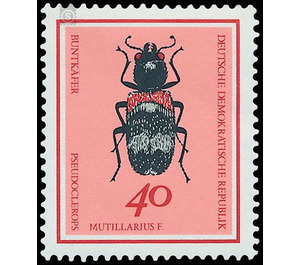Useful beetles - Germany / German Democratic Republic 1968 - 40 Pfennig
Theme: Animals
| Country | Germany / German Democratic Republic |
| Issue Date | 1968 |
| Face Value | 40.00 |
| Color | red |
| Perforation | K 13 1/2: 13 |
| Printing Type | offset |
| Stamp Type | Postage stamp |
| Item Type | Stamp |
| Chronological Issue Number | 1158 |
| Chronological Chapter | GER-DDR |
| SID | 101363 |
| In 16 Wishlists | |
Useful Beetles The Ministry of Posts and Telecommunications of the German Democratic Republic issues six multicolored special postal stamps with pictures of useful beetles. Useful beetles The total number of beetles living in Central Europe is difficult to specify; Sure, there are a few hundred species. The difficulty arises not least from the fact that the concept of usefulness is difficult to define. There are many beetles that play an important role in the household of nature and are therefore indirectly useful. Many Silphidae (carrion beetles) eliminate animal carcasses, the dung beetles bring feces under the ground, Georyssidae and Heteroceridae eliminate organic sludge at pond and stream edges. These are very important and useful activities. This circumstance should not be forgotten when talking about beneficial beetles, because in general one thinks first of all of beetle species that play an important role in the natural control of pests of agriculture or the forest. Many ground beetles (Carabidae) eat the terrestrial pests living on and in the soil, many short - winged (Staphylinidae) and long - tailed beetles (Histeridae) kill fly larvae, not a few beetles (Nitidulidae), flat beetles (Cucujidae), almost all colored beetles (Cleridae) track the pests of the Woods in their brood lobes, ladybirds, the larvae of numerous species of soft beetles (Malachiidae), Cantharidae, Dasytidae, etc.) eat leaf and stem pests. The motif series shows some because of their usefulness to be gentle, but less beneficial as beetle species. 40 Pfennig value: Pseudoclerops Mutillarius F. This species is a member of the family Buntkäfer (Cleridae), which owe their name to the colorful appearance of their body. Blue-red and green-red animals are very common in the family. Pseudoclerops is black-red and yellowish-white colored. The species is native to southern Central Europe and North Africa. In the territory of the GDR it is much rarer to meet than its close relative Thanasimus formicarius L. (ant beetle), which is similarly colored but slightly smaller. The beetle is most likely to be found at the gathering sites of felled conifers, in board mills or near wind or snow break in coniferous forests. The beetles crawl around on trunks and branches, are very nimble and catch the approaching or boring bark beetle. The beetles of this group eat bark beetles and other insects that are boring into the wood and thus prove beneficial. The more so, as well as the Buntkäfer larvae, which crawl in contrast to the Imagines in the corridors of the wood pests, feed on the same Holzzerstörern.


